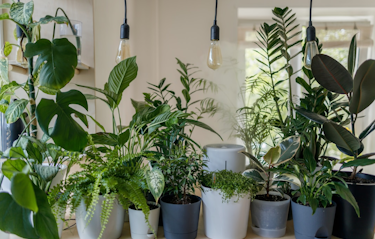
How To Trim Pothos
- Easy Care
- Araceae
- Large
- Evergreen Tropical Vines
We independently select everything we recommend. When you buy through our links, we may earn a commission.
Pilea plants are trendy, low-maintenance houseplants that have become popular among enthusiasts. There are two main ways to propagate pilea: stem cuttings or division.
Published on 22 August, 2023 by Ash Read
The Pilea genus encompasses more than 600 species. Some are succulents, and others are herbaceous perennials similar to nettles.
Some of the most popular types of Pilea indoor plants and their best propagation methods:
Chinese money plant (Pilea peperomioides plant): stem cutting
Aluminum plant (Pilea cadierei minima): stem cutting or division
Artillery fern (Pilea microphylla): stem cutting or division
Friendship plant (Pilea involucrata' Friendship'): stem cutting or division
Gray baby tears (Pilea libanensis) is a creeping variety: stem cutting or division
You will need a healthy parent plant with mature stems, a clean pair of pruning shears, and a small pot with well-draining soil or a jar of water.
Begin by selecting a stem from the parent plant that is at least four inches long and has several healthy leaves. Use shears to make a clean cut just below a node, where the leaves attach to the stem.
Next, remove the leaves from the stem's bottom 1-2 inches, leaving only a few leaves at the top. This will help the cutting focus its energy on developing roots rather than sustaining leaves.
If you are rooting the cutting in soil, make a small hole with a pencil or your finger and insert the stem, gently compacting the soil around it. Water the soil lightly, but don't overwater it, and put the pot in a warm, bright location away from direct sunlight.
If you are rooting the cutting in water, place the stem in a jar filled with water with the bottom 1-2 inches of the stem submerged. Leave the pot in a sunny spot away from direct sunlight, and change the water every few days.
After a few weeks, the cutting should begin to develop roots. Once these roots are at least an inch long, you can transplant the new plant into its pot or grow it in water.

Select a mature and healthy Pilea plant free from diseases and pests. Each section should have several leaves and a healthy root system. Ensure the plant has enough stems and roots to divide into smaller sections.
Get a clean and sharp pair of scissors or pruning shears, a container of fresh potting soil, and a few small pots or containers.
Carefully take the parent plant from its pot, not damaging the roots or stems. Remove any excess soil and dead or damaged leaves.
Gently separate the parent plant into smaller sections, ensuring each one has enough roots and stems to survive independently. Use your fingers, a clean knife, or scissors to separate the plant.
Repot the new plants: Plant each section in its own pot or container filled with fresh potting soil. Water the soil well and place the jars in a bright but not directly sunlit location.
Care for the new plants: Water the new plants regularly and make sure that the soil remains moist but not waterlogged. Keep the plants in a warm and humid location, away from cold drafts or direct sunlight.

Pilea plants like rich, well-draining potting mix. Choose soil with peat moss, perlite, and other organic matter to promote drainage and provide nutrients. Ensure your pots or containers have drainage holes to prevent root rot.
A mature Pilea mother plant will produce offsets or offshoots, also called "Pilea pups," which are tiny Pilea plants that sprout from the main plant.
Use a sharp knife to remove the plantlets and plant them in a new pot with a well-draining potting mix, keeping the soil moist but not waterlogged. To keep your Pilea plants healthy, place them in a well-lit area shielded from direct sunlight, as they thrive in indirect light. With proper care, new roots and new growth should appear in a few weeks.
As your baby Pilea plant grows, monitor its progress and give it the proper plant care it needs. Keep the soil moist but don't overwater, and fertilize the plant every few weeks. You may also notice new leaves appearing on your new plant, which is a good sign that it is thriving.
Delivered to your inbox every Saturday morning








